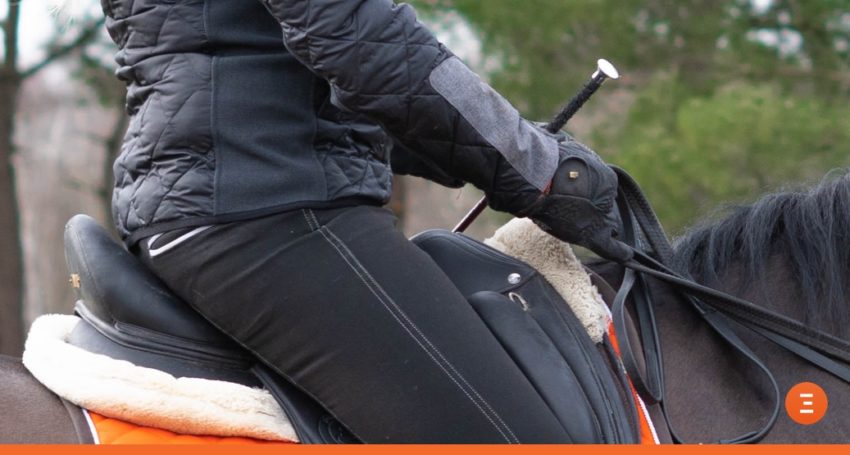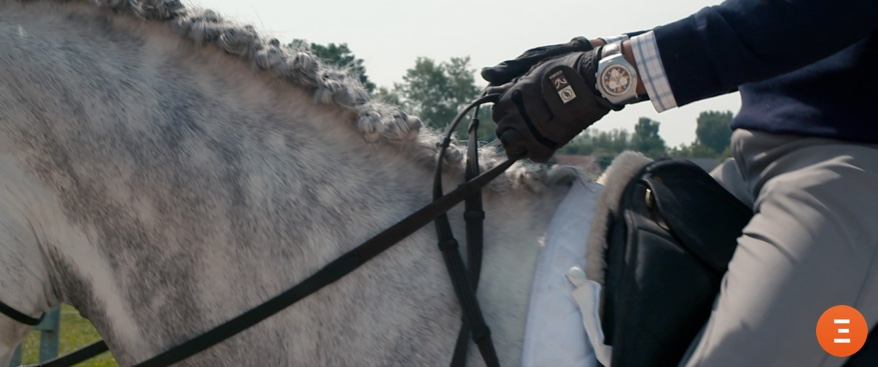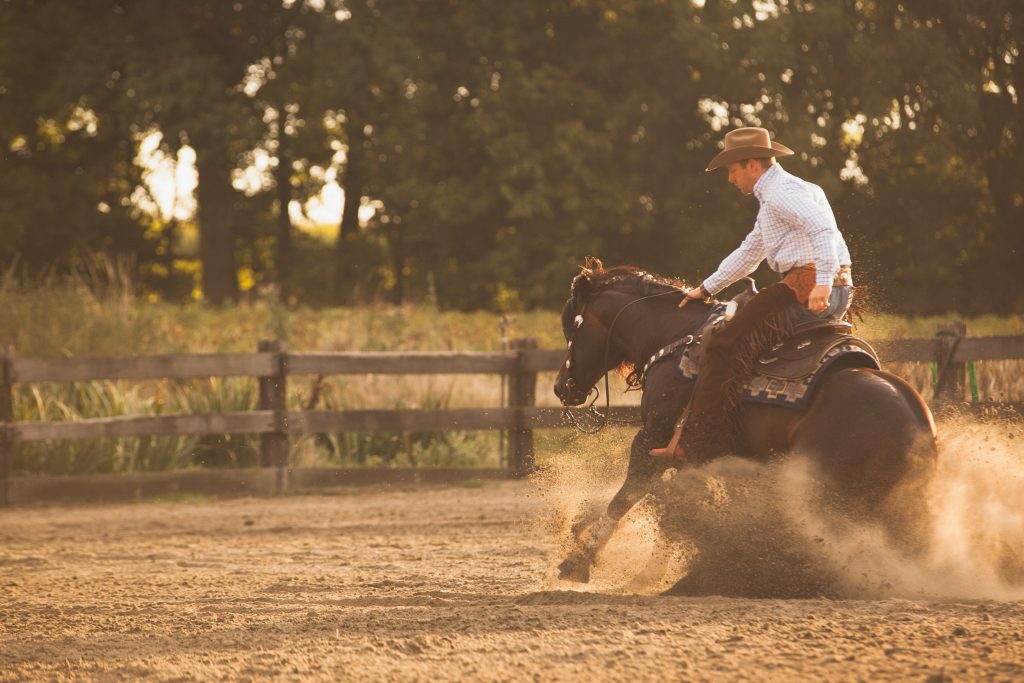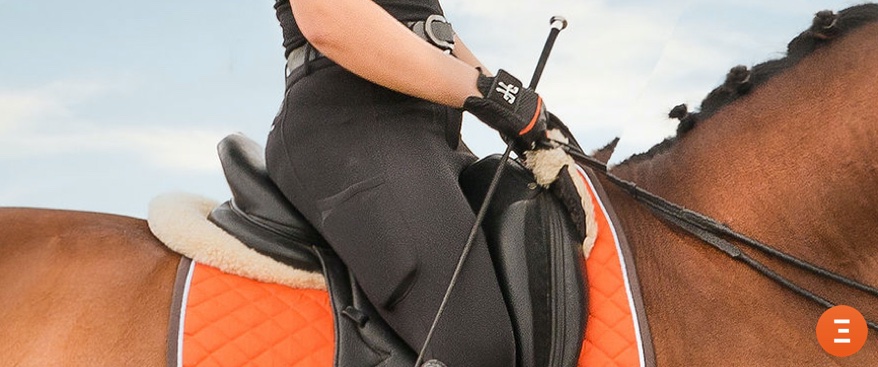
Here is how to ride with soft hands
Many riders have the bad habit of riding with a very hard hand on horseback, consciously or not. The problem is that it is very difficult to get rid of it. Let’s take a look at what it means to ride with soft hands.
Table des matières
The two ways to soften your hand on horseback
The problem of the hard hand comes from two things:
- tension in the reins that is too high: the rider “pulls” too much
- a lack of flexibility in the hands or arms: the rider is frozen
In the second case, the problem does not necessarily come from the tension, but more from the rider’s incapacity to accompany the horse’s swinging movements. The horse is then faced with a “wall” of hand.
Let’s do a quick review of the tension in the reins to understand what we are talking about.

All about tension in the reins
A tension is a stress undergone by a material “when it is subjected, at its extremities, to two forces directed towards the outside of the solid”. [1] The tension in the reins is therefore the force resulting from the action of your hands and the resistance of the horse’s mouth.
A tension is normally measured in Newton. 1N corresponds to the force created by the application of a 100g weight.
To make it simpler for the following, we will speak in kg and not in Newton to make it easier to understand, although it is not quite exact.
Read as well: 5 Minutes to Understand Bit Fitting for your horse
What are the orders of magnitude of the tensions we put in our reins?
Values sometimes very high…
What we find in the scientific literature really varies a lot. First of all, it varies with the gait, since it increases: less tension is applied at walk than at trot or at canter, and then it varies enormously according to the riders, the discipline and the context (in transitions for example). The variations are enormous, since it goes from a factor of 1 to… 80!
At walk, we find values of about 500g, 2kg in trot and 3kg in canter, and each time on one rein. But it can go much higher! Some studies have shown values of 150N or about 15kg on each rein, 25kg in a canter-halt transition, and up to 40kg in high speed trotters.
[2] [3] [4] [5] [6] [7] [8] [9]

… a tension that is not constant…
In addition to the average values, what you need to know is that even though it sometimes seems that the tension is constant, in fact it is not at all. There are cyclic variations that depend on the gait. We can see on the tension curves peaks that are synchronized with the strides (2 peaks per stride at walk and trot, 1 peak per stride at canter).
… and not symmetrical either!
Most riders think they have equal and constant tension in each rein, but the curves and values prove exactly the opposite. Most of us do not have the same tension values in both reins at all! And I assure you, neither do our horses! [2] [3] [6] [8] [10]

Let’s take the example of this professional rider measured over a little more than 7 strides at the canter. We can see the big peaks at each stride and the big difference between his two hands even though he thought he had a constant and symmetrical tension!
What tension values can the horse withstand?
This is an unresolved issue. It is not possible to give a precise limit value above which the tension becomes uncomfortable for the horses. [8] [11]
On the other hand, a researcher tried to find out how much tension the horse would put on without the influence of the rider. To do this, she took horses that were not broken in and therefore not used to the presence of a bit in their mouths, put fixed reins on them and offered them a bucket of food. By measuring the tension they applied to get the food, she realized that the horses applied a significantly higher tension on the first day of the test (1.02 kg on average and 4 kg at the maximum), then the tension values decreased from day to day (600g on average on the 2nd day and 570g on average on the 3rd day).
This shows how much the horses try to avoid too high tension [11] and we can see that they put a tension much lower than what we can impose on them…
Why is high tension a problem?
What you need to know is that keeping the tension too high all the time compromises the horse’s learning. This is because tension in the reins is negative reinforcement. For negative reinforcement to work, and therefore for the horse to understand what is expected of him, the pressure/tension must stop the moment he has done what was asked. This is why it is very important to ride with soft hands.
So if you ask your horse for a particular attitude, or if you ask him to turn, you apply tension. But as soon as he is in the requested attitude or as soon as he has started to turn, you must release the tension absolutely. Otherwise, he does not understand what is being asked. If the tension is not released, the trap slowly closes on the rider who will have to put more and more hand, and on the horse which will harden more and more.
💡 Learn more about negative reinforcement: 10 Horsemanship Ethology Principles every Rider should know

Our tips to ride with soft hands
First, know how to listen to your horse
The first thing to do is to know how to detect the signs that the hand is too hard or too frozen. For this, your horse will be your best ally, and some of his reactions can alert you. If he opens his mouth, if he grinds his teeth, if he passes his tongue or pulls it to the side or even retracts it, these are all signs that can alert you [8].
📚 Read as well: How about tightening the noseband of your horse less?
Some ideas of exercises to help ride with soft hands
The work on your sensations and your letting go will be essential to ride with soft hands. It is a long term work that awaits you. Among the possible solutions, here are some tested and approved by Equisense riders:
⏩ Solve other underlying problems
Often, riders compensate with the hand for a lack of reaction to the legs from the horse! A horse that does not hold itself laterally will tend to push the rider to act hard with the outside rein, or to make support reins too often. Working in a halter, or putting the reins on the noseband, or even working in the reins will help identify these leg response concerns and correct them. Once your horse is perfectly balanced and responding to your legs and body weight, your hand concern will be 90% resolved.
⏩ Work on letting go
Finally, the other recurring concern of hard-handed riders is the need for absolute control, and the lack of letting go!
Try to understand what you “fear”, what causes you to have a hard hand. What are you afraid of? What behavior are you trying to avoid? The fact of being aware and expressing clearly this fear (which may or may not be justified), will already allow you to reach a first step.
If necessary, get a mental trainer or a specialized coach to accompany you!
💡 On the same topic: How to deal with fear when riding
⏩ Work on proprioception
Proprioception is one of the main concerns of riders who have a hard hand. It is therefore necessary to work on the fact of recalibrating one’s sensations on what is right. Several techniques are available to you.
Ask yourself, “On a scale of 1 to 10, this action I just did is worth a 10, can I get the same thing with an action that would be worth a 9?” As you do this, you will be able to soften your hand.
Put two pairs of reins on the bit. Tie a knot on one of the pairs and leave it untouched. On the other pair, do not close the loop that connects it to the bit completely. This way, as soon as you put too much tension on it, the rein will come off.
Ride with very loose reins, and come up on them little by little until the horse does what is asked. Start with simple things first: transitions, resting on the bit, etc. As soon as you feel the horse tense up, start again by lengthening your reins.
Pretend you have play dough in your hands to loosen up as much as possible, or regularly scratch the withers or stroke the neck of your horse to loosen up.
On a walk-only session, get on half-length reins and try to do only circles, the track and figure eights, focusing only on the flexibility of your hands and arms. Try to be aware of any moments when you freeze, and release immediately. Imagine you are a rag doll!
Riding with soft hands on your horse is a crucial element of your success because it will determine the good understanding between you and your horse.
Arm yourself with a big dose of patience and a lot of letting go. But don’t be discouraged, proprioception can be worked on very well!
See you soon for a next article,
Camille Saute
Cofounder of Equisense and R&D Manager